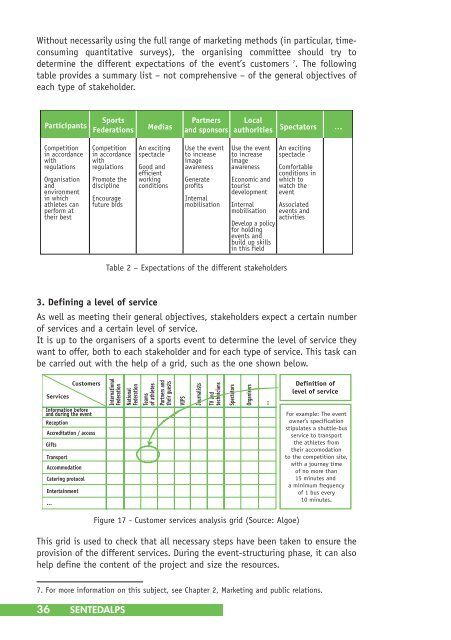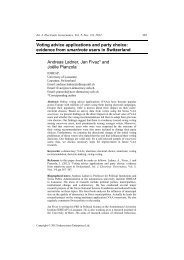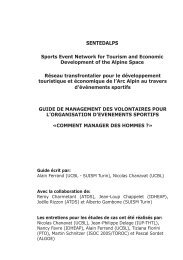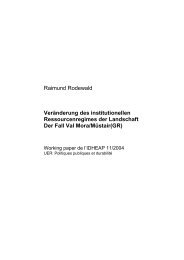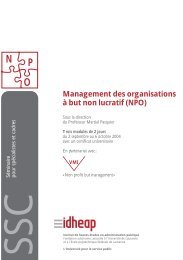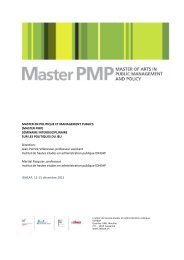organisational functions - Alpine-space.org
organisational functions - Alpine-space.org
organisational functions - Alpine-space.org
Create successful ePaper yourself
Turn your PDF publications into a flip-book with our unique Google optimized e-Paper software.
Without necessarily using the full range of marketing methods (in particular, timeconsuming<br />
quantitative surveys), the <strong>org</strong>anising committee should try to<br />
determine the different expectations of the event’s customers 7 . The following<br />
table provides a summary list – not comprehensive – of the general objectives of<br />
each type of stakeholder.<br />
Participants<br />
Sports<br />
Federations<br />
Partners Local<br />
Medias and sponsors authorities Spectators …<br />
Competition<br />
in accordance<br />
with<br />
regulations<br />
Organisation<br />
and<br />
environment<br />
in which<br />
athletes can<br />
perform at<br />
their best<br />
Competition<br />
in accordance<br />
with<br />
regulations<br />
Promote the<br />
discipline<br />
Encourage<br />
future bids<br />
An exciting<br />
spectacle<br />
Good and<br />
efficient<br />
working<br />
conditions<br />
Use the event<br />
to increase<br />
image<br />
awareness<br />
Generate<br />
profits<br />
Internal<br />
mobilisation<br />
Use the event<br />
to increase<br />
image<br />
awareness<br />
Economic and<br />
tourist<br />
development<br />
Internal<br />
mobilisation<br />
Develop a policy<br />
for holding<br />
events and<br />
build up skills<br />
in this field<br />
An exciting<br />
spectacle<br />
Comfortable<br />
conditions in<br />
which to<br />
watch the<br />
event<br />
Associated<br />
events and<br />
activities<br />
Table 2 – Expectations of the different stakeholders<br />
3. Defining a level of service<br />
As well as meeting their general objectives, stakeholders expect a certain number<br />
of services and a certain level of service.<br />
It is up to the <strong>org</strong>anisers of a sports event to determine the level of service they<br />
want to offer, both to each stakeholder and for each type of service. This task can<br />
be carried out with the help of a grid, such as the one shown below.<br />
Customers<br />
Services<br />
Information before<br />
and during the event<br />
Reception<br />
Accreditation / access<br />
Gifts<br />
Transport<br />
Accommodation<br />
Catering protocol<br />
Entertainment<br />
…<br />
International<br />
Federation<br />
National<br />
Federation<br />
Teams<br />
of athletes<br />
Partners and<br />
their guests<br />
VIPS<br />
Journalists<br />
TV and<br />
technicians<br />
Spectators<br />
Organisers<br />
…<br />
Definition of<br />
level of service<br />
For example: The event<br />
owner’s specification<br />
stipulates a shuttle-bus<br />
service to transport<br />
the athletes from<br />
their accomodation<br />
to the competition site,<br />
with a journey time<br />
of no more than<br />
15 minutes and<br />
a minimum frequency<br />
of 1 bus every<br />
10 minutes.<br />
Figure 17 - Customer services analysis grid (Source: Algoe)<br />
This grid is used to check that all necessary steps have been taken to ensure the<br />
provision of the different services. During the event-structuring phase, it can also<br />
help define the content of the project and size the resources.<br />
7. For more information on this subject, see Chapter 2, Marketing and public relations.<br />
36 SENTEDALPS


